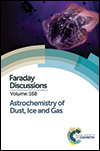The chemistry of planet-forming regions is not interstellar
Abstract
Advances in infrared and submillimeter technology have allowed for detailed observations of the molecular content of the planet-forming regions of protoplanetary disks. In particular, disks around solar-type stars now have growing molecular inventories that can be directly compared with both prestellar chemistry and that inferred for the early solar nebula. The data directly address the old question of whether the chemistry of planet-forming matter is similar or different and unique relative to the chemistry of dense clouds and protostellar envelopes. The answer to this question may have profound consequences for the structure and composition of planetary systems. The practical challenge is that observations of emission lines from disks do not easily translate into chemical concentrations. Here, we present a two-dimensional radiative transfer model of RNO 90, a classical protoplanetary disk around a solar-mass star, and retrieve the concentrations of dominant molecular carriers of carbon, oxygen and nitrogen in the terrestrial region around 1 AU. We compare our results to the chemical inventory of dense clouds and protostellar envelopes, and argue that inner disk chemistry is, as expected, fundamentally different from prestellar chemistry. We find that the clearest discriminant may be the concentration of CO2, which is extremely low in disks, but one of the most abundant constituents of dense clouds and protostellar envelopes.
- This article is part of the themed collection: Astrochemistry of Dust, Ice and Gas

 Please wait while we load your content...
Please wait while we load your content...